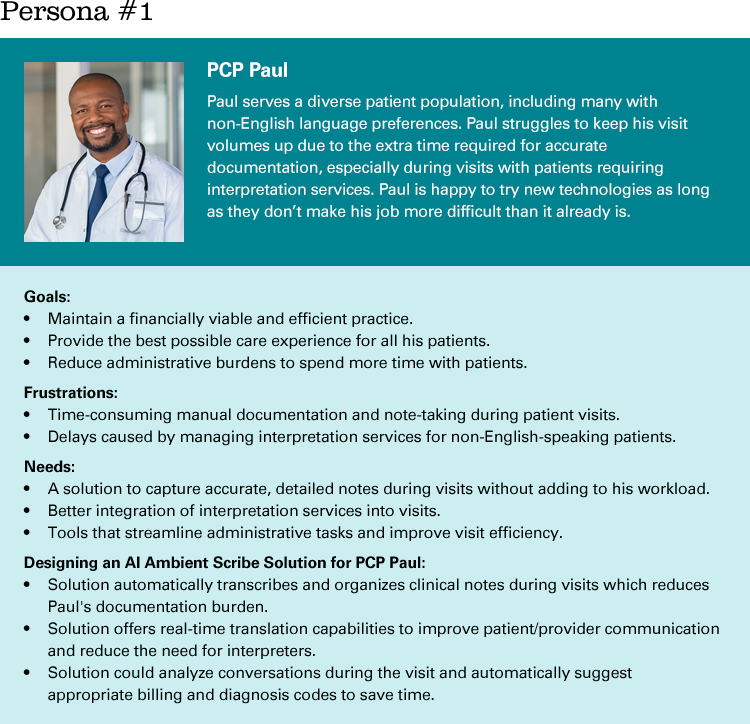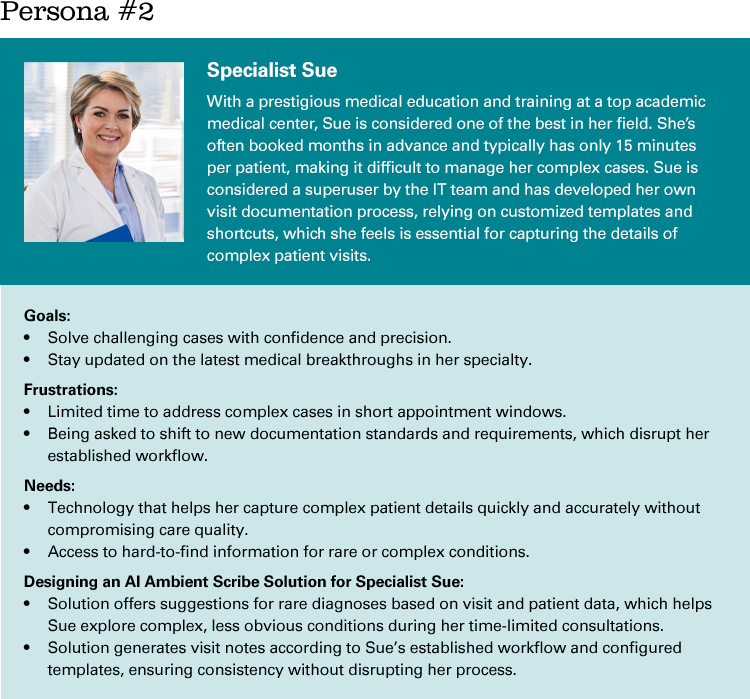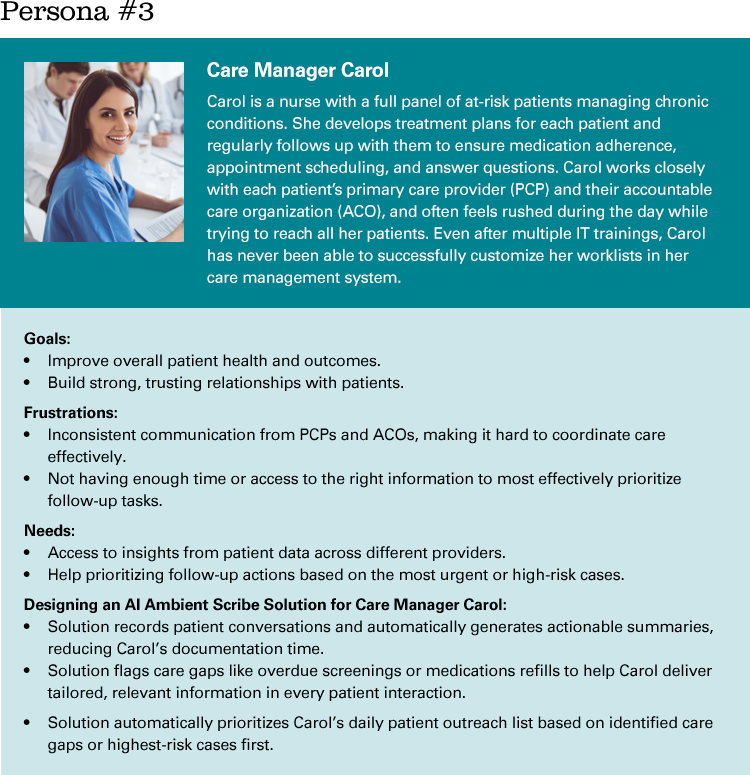How Health Systems Can Implement AI with a Human-Centered Design Approach
Contributors: ,
This is the latest edition of a Manatt Health series on AI for health systems, stemming from a recent Manatt Health white paper. Click to read the white paper and to read our previous issue.
As artificial intelligence (AI) solutions evolve and new clinical and operational use cases emerge, they will play a bigger role in the daily lives of many people across the health system. That’s why it is important to consider their impact on those who use and are affected by these technologies when organizations weigh their options and make design choices. Whether leaders build or buy AI solutions, design and implementation processes should:
- Seek to understand the problems they are solving for with these solutions;
- Establish a clear picture of the different end users of potential solutions across the health system; and
- Ensure solutions fit smoothly into existing workflows and improve the daily experience of the people who will use or be impacted by them.
To achieve these aims, health systems can take a human-centered design approach. is a process through which developers aim to understand the users of their solution and then generate prototypes and scenarios to test and rapidly iterate upon to create a solution that best fits the unique needs of the end users.
Human-centered design centers around four basic principles. The four principles are: people-centered, solve the right problem, everything is a system, and small and simple interventions. These principles ensure designers focus on creating technology solutions that ultimately serve the needs of their end users, improve their daily lives and do not negatively disrupt existing systems or ways of working. This process begins with understanding the needs of users and how they interact with technology, which can be accomplished through creating “user personas.”
User personas are a design tool through which fictional profiles are created representing key user groups that interact with a technology product or service based on real data and research. Personas capture the goals, frustrations and needs of users, helping organizations design solutions tailored to user experiences and personalities unique to their organization. Role-based personas are a common type of user personas, which incorporate both quantitative and qualitative data to create a profile based on their position or role within the organization, such as physicians, nurses, billers, call center staff or administrators. Personas can be given fictional names and other personal details to make them more realistic.
User personas should be created and tested by a cross functional team at the health system to ensure a broad set of views are included when defining types of users. Because AI solutions can serve vastly different purposes and be used by many different people across a health system, from supporting clinical decision-making for providers to streamlining operational workflows for administrators, it’s essential to incorporate the perspectives of many users—clinical and nonclinical, technical and nontechnical—to ensure the process is comprehensive and avoids bias, groupthink or blind spots.
Health systems can collect the necessary insights and data to create and test personas through interviews, job shadowing or by running reports. An understanding of technology usage patterns, workflow bottlenecks and real-life stories from end users help craft the persona’s behaviors, skills, needs and preferences for using technology solutions. An example of applying this approach to an AI solution is designing a clinical decision support (CDS) tool for physicians. Through interviews and shadowing, health systems could observe that physicians sometimes struggle with information overload when navigating multiple computer systems during patient visits. By incorporating this insight into a user persona, health system leaders can ensure the CDS tool is designed to work in the background of existing systems and workflows in order to reduce mental strain, rather than add to the existing burden.
When interviewing users to inform user personas, researchers should ask questions that uncover goals, challenges and needs. For example:
- “What are the biggest pain points or challenges you face in your daily work?”
- “What tools or solutions do you currently use, and what do you like or dislike about them?”
- “How would you prefer to receive information from or interact with technology?”
- “What would an ideal AI solution look like for you, and how would it improve your existing processes or assist with tasks you find challenging?”
After enough data is collected and analyzed by the design team assembling the user personas, the draft personas should be put to the test by running hypothetical user scenarios. Scenarios help evaluate how different personas may react to certain solutions being inserted into their workflows or how they would be impacted by implementation decisions. For example, a scenario could involve testing how different personas—like physicians, administrators and patients—would interact with an AI-powered appointment scheduling system that optimizes scheduling based on provider preferences, patient needs and resource availability. In this scenario, physicians might use the system to prioritize seeing patients with more complex conditions, while administrators might focus on optimizing resource use. This demonstrates how different users may choose to utilize the same solution for different goals.
User personas will surface key insights and new discoveries when used to evaluate potential AI solutions. For instance, assessing a predictive analytics tool for hospital readmissions through user personas might reveal that care managers need detailed reports to coordinate follow-ups, while physicians prefer real-time alerts integrated into their workflows. These user persona driven insights help the health system to select a solution that meets each group’s preferences without ignoring the needs of the other. Engaging in human-centered design conversations early ensures solutions target the root causes of inefficiencies—like communication breakdowns or workflow gaps—without creating new problems.
Example Health System Provider User Personas
To illustrate how health systems can incorporate this approach into their design and implementation processes, here are three examples of health system provider personas to consider while evaluating a potential AI ambient scribe solution. Ambient scribe solutions aim to reduce the clinical documentation burden by converting patient visit transcripts into structured notes. They are also expanding to include features like clinical coding suggestions and alerts for unresolved care gaps. Companies in this space include Abridge and Nabla.



The user personas above focus only on health system providers, but it’s important to consider other users, like patients or hospital administrators, when evaluating and designing AI solutions with user personas. A human-centered approach is key to ensuring AI improves the experience for everyone using the technology in their daily work or care settings. By regularly revisiting and updating user personas, organizations can stay flexible and adjust to changing roles and workflows, ensuring AI solutions create real value for the people who use them.
